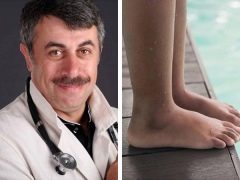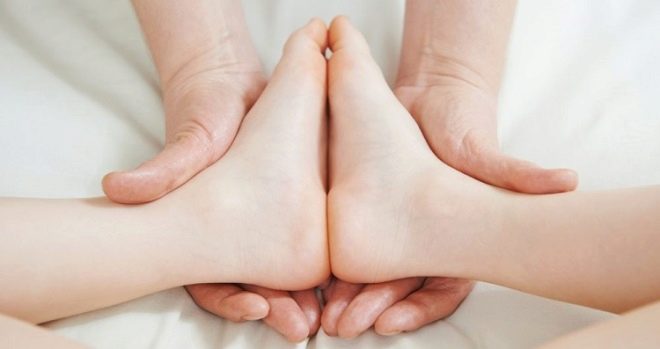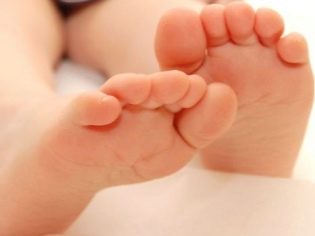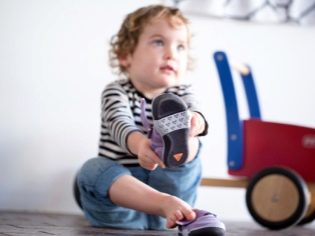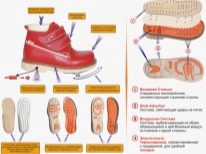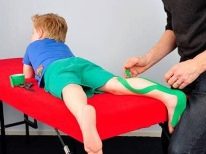Dr. Komarovsky about flat feet in children
The diagnosis of "flat feet" quite often sounds from the mouth of children's orthopedists. But there is not always a reason for anxiety. What is this pathology and why is it developing, says children's doctor Yevgeny Komarovsky, to whom parents regularly refer to this issue.
When is the diagnosis, and when is the norm?
Children's flatfoot is a topic for a serious conversation, says Yevgeny Komarovsky. At least because very often parents are responsible for shaping the pathology. The essence of pathology is in the deformation of the feet. The foot goes down, becomes flat. Than it is dangerous, it is not difficult to guess, because a large load is placed on the foot - body weight, and it is on the foot that the cushioning functions are assigned. If it is flat, then the load is distributed incorrectly, which leads to poor posture and gait, pain, deformation of other jointswhich are compelled to “compensate” for the defects of the foot - on the hip and knee joints.
However, the presence of flat-footedness does not always indicate a disease. All children are born with flat feet, and there are no other options. That is why the statement of the district medical officer that the baby has a flat foot in a year and a half should not be regarded as a call for urgent treatment. The legs of a newborn and an infant who does not walk are not under pressure, and therefore there is no biological necessity in the correct arching of the feet. Formation of the code itself begins later, and this process is usually completed by 8 years, says Yevgeny Komarovsky. Therefore, until this age, the diagnosis of "flat feet" is completely irrelevant.
But the prerequisites for the transition of physiological flatfoot to the pathological can be formed long before the age of seven. Most often this happens from year to three years. And such flat feet, when it will be revealed, is really in 95% of cases - the result of incorrect parental actions.
The muscles of the legs, ligamentous and tendon tissues of a small child are very weak, the cartilages are elastic, the wrong load can lead to deformational changes and violation of the height of the arch of the feet, that is, to flat feet. Early verticalization when the child is put on a walker or jumper is dangerous.without taking into account that the muscles of his lower limbs are not adapted to the vertical position of the body, dangerously so-called "active learning to walk"which some mothers start practicing almost from half a year, and alsocomfortable shoes and inadequate load on the foot after the baby starts walking.
In rare cases, according to Dr. Komarovsky, flat feet are formed in a child in his mother’s womb. These are cases of congenital flatfoot, in which the skeleton of the foot was originally “designed” wrong. There are few exit options - just an operation. Thus, in most cases, there is nothing unusual in flat-footedness in children under 7 years of age, but then you need to visit an orthopedist and find out if everything is in order and what to do next. The final formation of the foot is completed in children by 11-12 years. If at this age the corresponding diagnosis sounds and it is confirmed by diagnostic methods, then a conservative correction usually does not bring much success.
The reasons
The most mysterious can be considered the causes of congenital violation of the height of the arch of the feet.It is very difficult after the child is born, to figure out what went wrong and why during the period of its prenatal development. It is believed that heredity and underdevelopment or abnormal development of muscle and tendon tissues can affect.
Most often, children do not find anatomical, and acquired flat feet, and almost always it is somehow related to the weakness of the connective tissue. Prerequisites for the development of flat feet can be transferred rickets, fractures of the calcaneus, polio.. However, such problems as poliomyelitis are now quite successfully solved by vaccination, and rickets due to the availability and free access of water-soluble vitamin D is also classified as not so frequent.
Inadequate loads on the feet are more common in flat feet after 8-10 years. Reducing the arch of the foot can cause low physical activity, uncomfortable shoes, which also does not fit the child in size. In the best way, the feet are formed in children whom, according to Komarovsky, parents are allowed to run barefoot not only around the apartment, but also on the street, who move a lot.
How to determine?
You should not try to consider something in children under 8 years of age. Almost all feet are flat. And only if the problem has the most rare innate nature, there may be some differences - both feet will be flat, like a carbon copy. The soles will be convex, and the outer part of the feet somewhat concave. Lean the child will be strictly on the heel, while spreading his fingers.
At an older age, the warning signs that may indicate a possible flattening of the feet will be:
- fatigue when walking;
- complaints of pain and aches in the legs, worse in the evenings;
- slight swelling of the legs after a day in the evening;
- Any pair of shoes in a child is worn out in a very specific and special way - the inside of the sole and heel is erased.
Pronounced and already complicated flatfoot leads to a heavy gait, some awkwardness, pain in the lower back. Mobile flat-footedness in most children is generally asymptomatic, and in eight out of ten children it goes on its own with the onset of adolescence. Also, do not forget that the larger the stage, the more pronounced the symptoms, and therefore independently see flat feet at the initial stage, parents can hardly do. With transverse flatfoot, a child may exhibit special symptoms - frequent ingrown of the thumbnail, for example.
Komarovsky argues that the installation of visual inspection is unacceptable. It is imperative to ask the orthopedist to appoint, if he has not done so, X-rays, stop, and other methods that allow to establish the fact of flatfoot, stage, appearance, and only then prescribe treatment.
Treatment
Komarovsky considers any actions of a therapeutic nature reasonable and permissible after As the diagnosis is confirmed at the age after 7-8 years. Before - nothing needs to be treatednature just need not interfere. When the need for treatment is obvious, several methods can be offered to parents. Surgical is most often indicated for congenital flatfoot, as well as severe deformity of the foot. In most cases, conservative treatment is recommended..
It includes massage and medical gymnastics, the task of which is to improve the blood supply to the feet, increase the elasticity of the ligaments, strengthen the muscle frame. Additionally after the second degree flatfoot can be recommended by an orthopedist certain models of therapeutic orthopedic shoes. She has nothing to do with what is commonly called orthopedic sellers of children's shoes. It is a custom made, heavy and uncomfortable footwear, which is made solely on the basis of the individual deformation of the foot of the child. Usually it is very expensive.
In recent years kinesiotiping methods are widely used (fixation of certain parts of the foot with adhesive tapes - “tapes”). Treatment should become a way of life - gymnastics and home massage should not be forgotten, you also need to make sure that the child moves sufficiently and correctly. With regard to operational assistance, from the age of 10, children undergo such an operation as podtalic arthroeresis, in which a titanium fixator is inserted into the foot through a small incision. There are also operations of Evans and other types of surgical treatment that solve the problem radically.
Prevention
It is to this issue that Dr. Komarovsky recommends paying close attention, because flat feet are easier to prevent than to cure. As soon as the child takes the first steps, it's time to think about the proper development of muscles and tendons, ligaments of the legs. It is best to give the child the opportunity to go barefoot; shoes should be outfitted with a high back and soft non-slip soles.. Up to 2-3 years, and other shoes do not need, the more you should avoid shoes with "adult" designs.
You can buy a home massage mat, which after a gym you can walk for a few minutes. Up to 9 months of age, Yevgeny Komarovsky does not advise using walkers and jumpers as possible triggering deformation devices. Better to encourage the child longer crawl.
In preschool age, slaps and slippers are bad, their wearing should be quite severely limited. You need to monitor diet and physical activity. More mobile and thin children are less prone to pathological flat-footedness than toddler with obesity, leading a sedentary lifestyle.
The next video will talk about congenital flatfoot, which can not be influenced, and acquired, which is due to improper child care.
